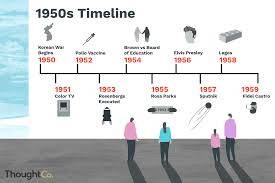The 1950s marked a transformative decade in global history, defined by post-World War II reconstruction, the Cold War rivalry, and significant social and cultural shifts.
Economic Recovery and Boom:
Coming out of the devastation of World War II, the 1950s saw a remarkable economic recovery in many parts of the world, particularly in Western Europe and the United States. The United States, having emerged as a dominant global power, experienced unprecedented economic growth. This period, often referred to as the “Economic Miracle,” was characterized by booming industries, technological innovation, and a rising standard of living for many.
Cold War Tensions:
The 1950s were deeply influenced by the Cold War, the ideological and geopolitical standoff between the United States and its allies in the West and the Soviet Union and its satellite states in the East. This rivalry led to intense military buildups, nuclear arms races, and proxy wars, such as the Korean War (1950-1953) and the Cuban Missile Crisis (1962). The fear of nuclear conflict shaped international relations and domestic policies throughout the decade.
Social Changes:
Socially, the 1950s were a period of both conformity and change. In the United States, there was a cultural emphasis on traditional gender roles and family values, exemplified by the idealized suburban lifestyle portrayed in popular media. However, beneath this conformity, significant social movements began to emerge. The Civil Rights Movement gained momentum, challenging racial segregation and discrimination. Figures like Martin Luther King Jr. became prominent voices advocating for equality and justice.
Cultural Revolution:
The 1950s also witnessed a cultural revolution, particularly in music, fashion, and entertainment. Rock and roll emerged as a powerful force, blending rhythm and blues with country music to create a new sound that captured the spirit of youthful rebellion. Artists like Elvis Presley and Chuck Berry became icons of the era, influencing generations to come. Hollywood produced iconic films that reflected the era’s aspirations and anxieties, from glamorous musicals to tense Cold War thrillers.
Technological Advances:
Advancements in technology defined the 1950s. The Space Race began in earnest as both the United States and the Soviet Union competed to achieve milestones in space exploration. In 1957, the Soviet Union launched Sputnik, the first artificial satellite, triggering fears of technological and military inferiority in the West. This event spurred increased investment in science and education, laying the groundwork for future innovations.
Global Decolonization:
The 1950s also witnessed significant changes in global politics with the process of decolonization gaining momentum in Africa and Asia. Former colonies gained independence, reshaping the geopolitical landscape and challenging established power dynamics. Leaders like Kwame Nkrumah in Ghana and Jawaharlal Nehru in India became symbols of post-colonial aspirations for self-determination and development.
Legacy:
The legacy of the 1950s endures in shaping modern politics, culture, and society. It was a decade of contrasts: of economic prosperity and Cold War tensions, of social conformity and cultural revolution. The events and movements of the 1950s laid the foundation for the transformative decades that followed, leaving a lasting imprint on the course of history.
In conclusion, the 1950s were a pivotal era characterized by rapid change, economic growth, social upheaval, and technological innovation, setting the stage for the modern world we live in today.


